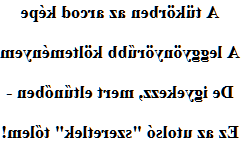Hungarian love poem
A tükör
A tükörben az arcod képe
A leggyönyörűbb költeményem
De igyekezz, mert eltűnőben -
Ez az utolsó "szeretlek" tőlem!

Another version
A tükör
A képed a tükörben
A legszebb versem
De siess, mert eltűnik
Ez az utolsó szeretlek tolem

→ French poem ←
Hungarian woman & language
Hungarian, mixed desire, and memory, it's Magyar költeménye. The image of woman is eternal. This Hungarian love poem (Szerelmi vers) is an example. Whether you are Brigitta, Hajnalka or Klára, you know that you could not be another, that no one else is like you.
The Hungarian language (other names that can be found : Northeastern Hungarian, Southern Great Plains, Tisza–Körös, Székely, Palóc, Oberwart, Southern Transdanubian, Mezoségi, Central Transdanubian, Western Transdanubian, Csángó, Autonym : Magyar), is one of the Ugric languages and has 14 million speakers.
14 million of new readers for my translated poem, wahooo! They are found in Hungary but also in Slovenia the two countries from where it is the official language, and in the surrounding countries (Romania, Serbia, Slovakia, Croatia), reminiscent of the Versailles treaties which affected the country.
The Finno-Urgrians represented a linguistic unit in the southwestern region of the Urals in 2000. It is thought that in 1000, Hungarian, which was one of the dialect forms, had emmerged. During the 6th century, these people who spoke this dialect would have left Ural to go to the Carpath. They havec established the Hungarian kingdom at the end of the first millennium.
Hungary is a country of plains straddling the Danube, its large reserves of water and alluvial deposits have made it one of the most beautiful agricultural region in Europe.
Hungarian literature
The first written traces are in Latin and Greek around 1000, and for those in Hungarian around 1200.
In the Middle Ages we already finds an important Hungarian literature which includes legends and religious poems. Hungarian becomes a veritable language of civilization and literature in the 16th century. Then emmerge the names of the poets Sebestyen Tinodi and especially Balint Balassi. In the 17th Miklos Zrinyi, poet speaker and warlord, and Istvan Gyongyosi are figures of the baroque literature.
In the 18th century poetry is represented by Lazlo Amade and Ferenc Faludi. Ferenc Kazinczy, poet, writer, translator profits from the reform which institutionalizes the Hungarian. Janos Bacsanyi, Mihaly Csokonai Vitez and Daniel Berzsenyi lay the foundations of Hungarian poetics.
In the 19th Janos Arany draws the subjects of his epic poems in the history of the nation. The revolution of 1848 is expressed in the poems of J. Garai, Janos Erdelyi, Mihaly Tompa, the most brilliant novelist is Mor Jokai.
After 1860 the lyric poets evolved towards Impressionism, then towards Symbolism, such as Janos Vajda, Gyula Reviczky, Jeno Komjathy and Sandor Endrodi. After the 1st World War the Hungarian poet Attila Jozsef compose a poem of socialist inspiration. 1945 is followed by a great literary effervescence. We notice the poet Sandor Weores and Sandor Marai "Embers".